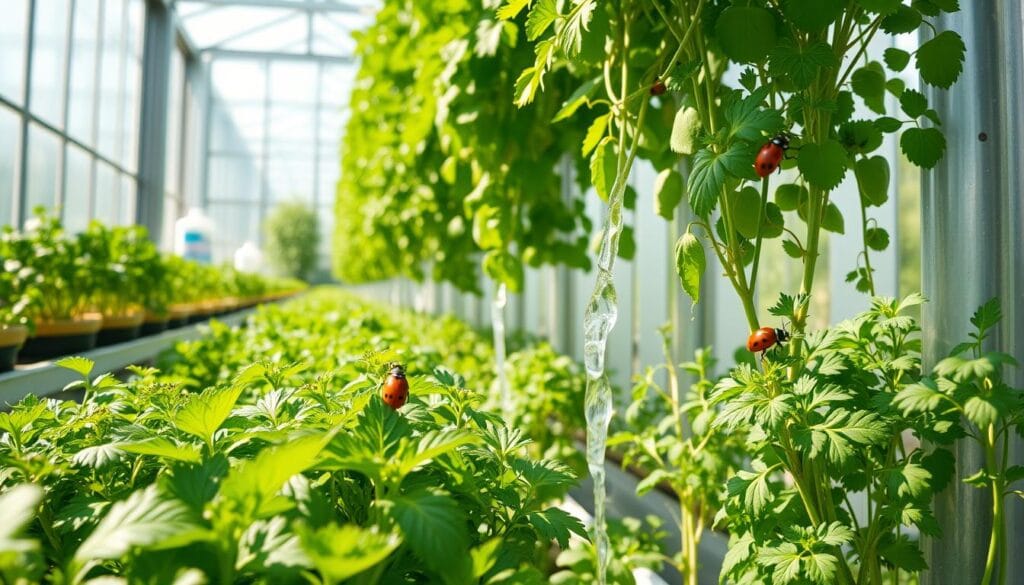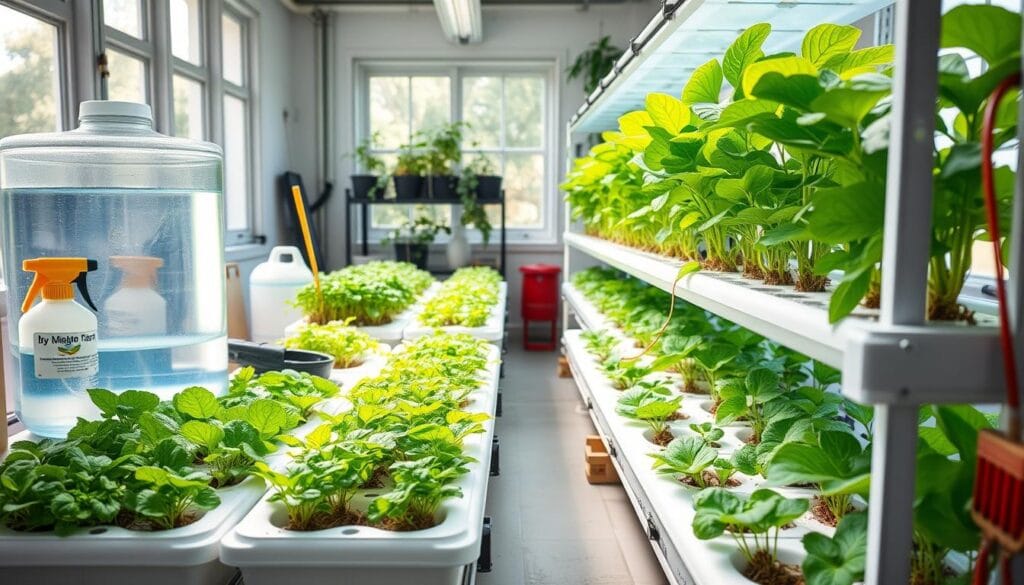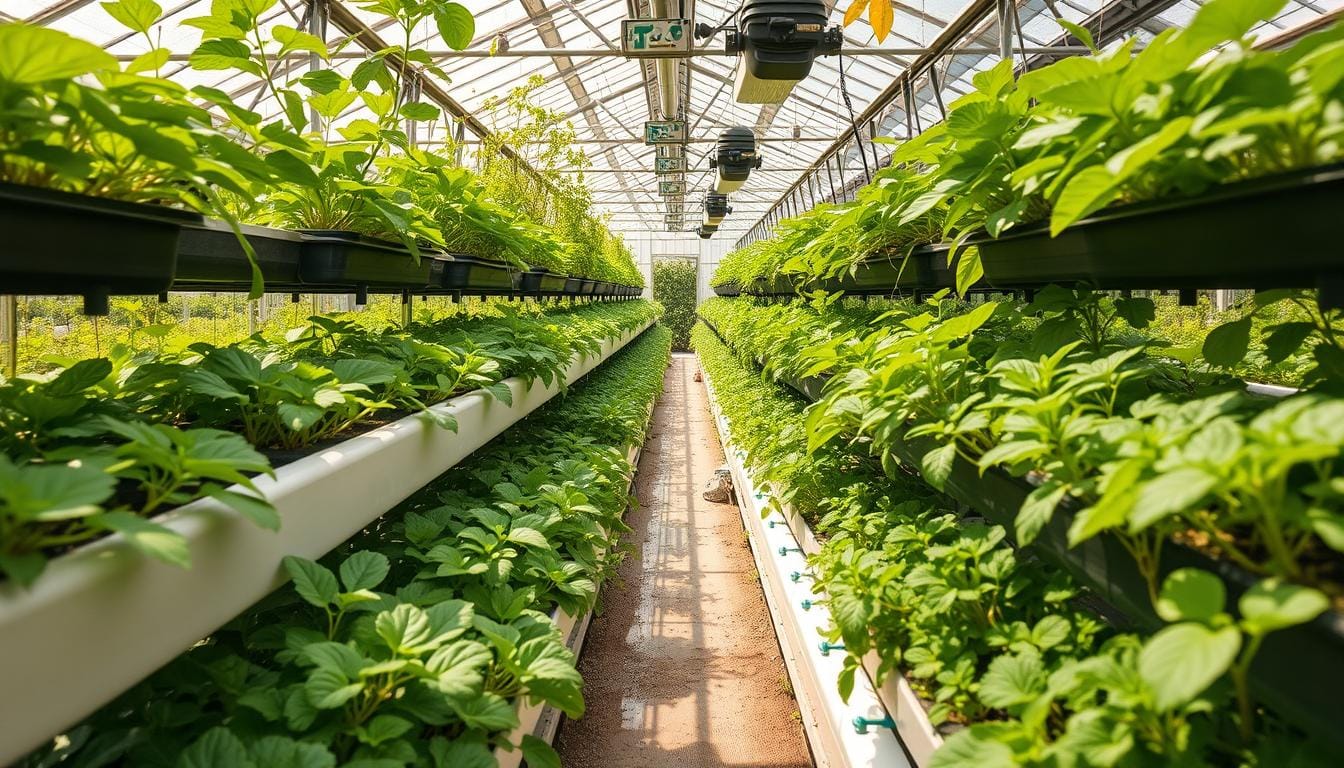As a gardener, seeing your crops fall to pests is frustrating. But, there’s a way to fight back and protect your plants. Welcome to hydroponic pest management, where new methods change how we grow food.
Imagine a garden where your plants grow strong, free from pests. Hydroponic farming gives you control and precision. It uses nutrient-rich water and special growing systems to keep pests away.
Key Takeaways
- Water usage in hydroponic gardening can be reduced by up to 95% when compared to conventional farming.
- Proper system design and environmental management are crucial for preventing pest infestations in hydroponic setups.
- Integrated Pest Management (IPM) combines various control techniques to manage pests sustainably and effectively.
- Biological control, using natural predators or parasites, can be a powerful tool in hydroponic pest management.
- Combining various chemical, organic, and environmental approaches can create a comprehensive pest control plan for hydroponic farms.
In this guide, we’ll explore the top five strategies for hydroponic pest management. Say goodbye to pests and greet a vibrant,abundant harvest.
Understanding Hydroponic Growing Systems and Pest Vulnerability
Hydroponic systems offer many benefits over traditional farming. Yet, they are not safe from pests. These controlled environments face challenges from pests that harm plant health and productivity. To manage pests well, knowing common entry points, environmental factors, and system design is key.
Common Entry Points for Pests
Pests can enter hydroponic systems in several ways:
- New plants introduced into the system
- Contaminated gardening tools and equipment
- Airborne pests entering through openings in the growing area
Environmental Factors Contributing to Infestations
The controlled environment of hydroponic systems attracts pests. Stagnant water, high humidity, and nutrient-rich media are perfect for breeding insects and pathogens.
Impact of System Design on Pest Prevention
The design of your hydroponic system affects its pest resistance. Proper drainage, air circulation, and plant spacing are crucial. Understanding these design elements helps you prevent pests.
By focusing on these areas, you can manage pests effectively in your hydroponic operation. This ensures your crops stay healthy and productive. Stay tuned for more on common pests and pest management strategies.
Common Pests in Hydroponic Systems
Keeping a hydroponic farm healthy means watching out for pests. Aphids, spider mites, thrips, whiteflies, and fungus gnats can harm your crops if not stopped.
Aphids, tiny insects, suck sap from plants. They can spread diseases too. Spider mites make webs that hurt leaves. Thrips are small and can cause spots on leaves and spread diseases.
Whiteflies are similar to aphids, but they reside on the underside of leaves. Fungus gnats harm roots, causing plants to grow poorly.
- Aphids are about 1/8 of an inch, found on new plant growth.
- Whiteflies are similar in size, living on the underside of leaves.
- Spider mites are tiny, oval, and come in many colors.
- Thrips are small, black or green, with tiny wings.
Keeping your hydroponic system clean is key. Use natural controls and watch your plants closely. This way, you can keep your crops healthy and growing well.
Key Components of Hydroponic Pest Management
Managing pests in hydroponic farming needs a few key steps. These include prevention, monitoring, and control. By focusing on these areas, growers can keep their hydroponic systems healthy and pest-free.
Prevention Methods
Stopping pests before they start is key. Regular checks, keeping growing conditions right, and cleaning equipment are important. Watching temperature, humidity, and nutrient levels helps keep pests away.
Monitoring Techniques
Finding pests early is crucial. Growers use sticky traps and magnifying glasses to spot pests like aphids and spider mites. This early action stops infestations from getting out of hand.
Control Strategies
When pests are found, growers use different methods to fight them. This includes removing pests by hand, introducing good bugs, and using pesticides carefully. These steps help manage pests well in hydroponic systems.
| Prevention Methods | Monitoring Techniques | Control Strategies |
|---|---|---|
|
|
|
Using a full plan for pest and disease management helps growers. This way, they can keep their hydroponic systems healthy and productive.
Biological Control Methods for Hydroponic Farming
Managing pests in hydroponic farming can be done in a green way. Natural predators help control pests without harsh chemicals. This approach is good for the environment.
Introducing beneficial insects like ladybugs and lacewings is a common strategy. These insects eat pests like aphids and whiteflies. Nematodes are great for fighting pests in the soil.
Spiders and other insects contribute by feeding on pests. This keeps the system balanced. It also means you use fewer chemicals and have a healthier ecosystem.
| Biological Control Method | Target Pests | Benefits |
|---|---|---|
| Ladybugs and Lacewings | Aphids, Thrips, Whiteflies | Effective natural predators, Promote ecological balance |
| Nematodes | Soil-dwelling Pests | Target specific pest species, Eco-friendly control |
| Spiders and Predatory Insects | Diverse Pest Species | Maintain natural pest-predator relationships, Reduce chemical reliance |
Using biological control methods is a smart choice for hydroponic farming. It’s a method of controlling pests without damaging the environment. This approach is better for your crops and the planet.
“Integrated Pest Management (IPM) combines a range of strategies, including biological, mechanical, cultural, and chemical methods, to effectively manage and control pests in hydroponic farming.”
Chemical and Organic Solutions for Pest Control
To keep your hydroponic system pest-free, you need a mix of organic and synthetic methods. Organic pest management uses natural pesticides and biological controls. These methods help protect the environment around your hydroponic setup.
Natural Pesticides and Their Application
Using neem oil and pyrethrin can stop pests like aphids and whiteflies. Insecticidal soaps work well against soft-bodied insects. Always read the instructions on these natural pesticides to use them safely and effectively.
Synthetic Options and Safety Measures
Synthetic pesticides can fight pests, but use them carefully. If not used properly, they can harm the environment and people. Always adhere to the safety instructions when using these products.
Integration of Different Control Methods
- Use biological controls and organic treatments together for organic pest management.
- Set up physical barriers, like screens, to prevent pests and reduce chemical use.
- Check your hydroponic system often and fix problems early to keep it pest-free.
By using a variety of organic pest management methods, you can create a sustainable pest control system. This system uses fewer synthetic chemicals and keeps your plants healthy.
Environmental Management and Climate Control
Keeping a good environment is key to stop pests and diseases in hydroponic systems. By managing temperature, humidity, and air, you can keep pests away and help plants grow well.
It’s important to keep the right temperature and humidity for plants. For instance, lettuce thrives et temperatures between 18°C and 24°C (64°F to 75°F), while tomatoes grow best at 21°C to 27°C (70°F to 80°F). This helps stop pests like spider mites that like dry air.
Good air flow is also crucial. Fans can make it hard for flying pests to stay in your hydroponic system. Also, keeping humidity right is key, as too much can attract pests and fungi.
Cleaning and managing water are also key to stop pests. Getting rid of debris, cleaning tools, and making sure water drains well can stop pests and diseases. By managing your growing space well, you can keep pests and diseases away, helping your hydroponic system thrive.
| Environmental Factor | Optimal Range | Impact on Pest and Disease Management |
|---|---|---|
| Temperature |
| Maintaining optimal temperatures can discourage pests like spider mites that thrive in dry conditions. |
| Humidity | Balanced levels | Preventing stagnant, moist conditions that attract mosquitoes, fungus gnats, and promote fungal growth. |
| Air Circulation | Gentle, simulated breezes | Discouraging the establishment of flying pests in the hydroponic system. |
| Cleaning and Water Management | Regular maintenance | Eliminating standing water and debris to prevent pest infestations and disease spread. |

“Proper environmental management is the foundation for effective greenhouse pest control and hydroponic disease management in any successful hydroponic system.”
Advanced Technology in Hydroponic Pest Management
The world of hydroponic farming is changing fast. New technologies are making it easier to manage pests. These advancements help growers keep their systems healthy and pest-free.
Automated Monitoring Systems
Automated monitoring systems are changing the game. They watch over things like temperature, humidity, and light. When conditions get right for pests, they alert growers right away.
Growers can then act fast to stop pests before they cause big problems. This keeps their crops safe and healthy.
Smart Pest Detection Tools
Smart pest detection tools use sensors and cameras to spot pests early. They can tell what kind of pest is there and how bad it is. This lets growers take the right steps to stop the problem.
By catching pests early, growers can save their crops. They can also use better ways to control pests.
Data-Driven Prevention Strategies
Hydroponic technology and data analysis are making pest control smarter. Growers can look at past data to predict when pests might show up. This helps them stop pests before they start.
Using data this way means growers can use their resources better. They can focus on the right areas and keep their crops better.
As hydroponic farming grows, so does the use of new tech. Growers now have tools like automated systems, smart detection, and data analysis. These help them keep their farms healthy and productive.
Best Practices for System Maintenance and Sanitation
Keeping your hydroponic system clean and well-maintained is key to avoiding pests and ensuring it works its best. By sticking to these best practices, you can keep your plants safe and make the most of your hydroponic setup.
Regular Cleaning and Disinfection
- Make it a habit to clean reservoirs, pipes, and growing trays to get rid of algae, debris, or mineral deposits.
- Use a diluted hydrogen peroxide solution (1 part hydrogen peroxide to 10 parts water) or a food-grade sanitizer to disinfect system parts.
- Flush your system thoroughly every few weeks to get rid of any built-up salts or nutrients.
Proper Nutrient Management
- Change the nutrient solution every 1-2 weeks to keep nutrient levels right and prevent pathogen buildup.
- Check the electrical conductivity (EC) of the nutrient solution, aiming for 1.0 to 2.5 mS/cm.
- Keep the water temperature between 65°F and 75°F (18°C – 24°C) for best nutrient uptake and plant health.
Pest Prevention and Control
- Keep an eye out for pests like aphids, spider mites, whiteflies, and thrips on your plants.
- Use biological control methods, such as introducing ladybugs or applying organic pesticides like neem oil, to manage pests.
- Use physical barriers like row covers or insect netting to keep pests away from your plants.
Crop Maintenance and Hygiene
- Quickly remove any dead or diseased plant material to stop pests and pathogens from spreading.
- Keep plants spaced right and prune them to reduce stress and limit pest spread.
- Always quarantine new plants for a period before adding them to your hydroponic system to prevent the spread of pests or diseases.
By following these best practices for hydroponic system maintenance and plant protection, you can create a thriving, pest-free hydroponic environment. This environment will support the healthy growth of your plants.

Conclusion
Effective hydroponic pest management is key for successful and sustainable crop growth. Knowing pests’ weaknesses in hydroponic systems helps. It also means using preventive steps and integrated control methods.
Using biological controls and advanced tech is important. So is keeping the environment just right. These steps protect your plants and boost your hydroponic farm’s efficiency.
By focusing on effective hydroponic farming and pest control, you can reach new heights. With good planning and constant improvement, you can grow healthy, pest-free crops. These crops will give you plenty to harvest and help make our food system more sustainable.

